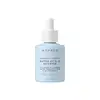What's inside
What's inside
 Key Ingredients
Key Ingredients

 Benefits
Benefits

 Concerns
Concerns

 Ingredients Side-by-side
Ingredients Side-by-side

Aronia Melanocarpa Fruit Extract
Skin ConditioningButylene Glycol
HumectantPropanediol
SolventBetaine
HumectantPanthenol
Skin ConditioningNiacinamide
Smoothing1,2-Hexanediol
Skin ConditioningAscorbyl Tetraisopalmitate
AntioxidantHydroxyethyl Acrylate/Sodium Acryloyldimethyl Taurate Copolymer
Emulsion StabilisingCetearyl Olivate
Sorbitan Olivate
EmulsifyingAllantoin
Skin ConditioningTocopherol
AntioxidantAdenosine
Skin ConditioningSodium Hyaluronate
HumectantBakuchiol
AntimicrobialAlpha-Arbutin
AntioxidantFerulic Acid
AntimicrobialCentella Asiatica Oil
AntimicrobialGlycine Soja Oil
EmollientAronia Melanocarpa Fruit Extract, Butylene Glycol, Propanediol, Betaine, Panthenol, Niacinamide, 1,2-Hexanediol, Ascorbyl Tetraisopalmitate, Hydroxyethyl Acrylate/Sodium Acryloyldimethyl Taurate Copolymer, Cetearyl Olivate, Sorbitan Olivate, Allantoin, Tocopherol, Adenosine, Sodium Hyaluronate, Bakuchiol, Alpha-Arbutin, Ferulic Acid, Centella Asiatica Oil, Glycine Soja Oil
Water
Skin ConditioningPropanediol
SolventGlycerin
HumectantCaprylic/Capric Triglyceride
MaskingBetaine
HumectantNiacinamide
SmoothingAscorbyl Glucoside
AntioxidantSea Silt Extract
Skin ConditioningAcrylates/C10-30 Alkyl Acrylate Crosspolymer
Emulsion StabilisingCarnosine
Skin ConditioningCarrageenan
Cellulose Gum
Emulsion StabilisingCitric Acid
BufferingCopper Gluconate
Skin ConditioningHimanthalia Elongata Extract
Skin ProtectingHumulus Lupulus Oil
MaskingHydroxyacetophenone
AntioxidantLecithin
EmollientLeontopodium Alpinum Callus Culture Extract
AntioxidantMagnesium Aspartate
Skin ConditioningMaris Sal
Skin ConditioningPullulan
Sclareolide
MaskingSclerotium Gum
Emulsion StabilisingSodium Chloride
MaskingSodium Phytate
Xanthan Gum
EmulsifyingZinc Gluconate
Skin ConditioningZingiber Officinale Root Extract
MaskingPhenoxyethanol
PreservativePotassium Sorbate
PreservativeSilica
AbrasiveSodium Benzoate
MaskingWater, Propanediol, Glycerin, Caprylic/Capric Triglyceride, Betaine, Niacinamide, Ascorbyl Glucoside, Sea Silt Extract, Acrylates/C10-30 Alkyl Acrylate Crosspolymer, Carnosine, Carrageenan, Cellulose Gum, Citric Acid, Copper Gluconate, Himanthalia Elongata Extract, Humulus Lupulus Oil, Hydroxyacetophenone, Lecithin, Leontopodium Alpinum Callus Culture Extract, Magnesium Aspartate, Maris Sal, Pullulan, Sclareolide, Sclerotium Gum, Sodium Chloride, Sodium Phytate, Xanthan Gum, Zinc Gluconate, Zingiber Officinale Root Extract, Phenoxyethanol, Potassium Sorbate, Silica, Sodium Benzoate
 Reviews
Reviews

Ingredients Explained
These ingredients are found in both products.
Ingredients higher up in an ingredient list are typically present in a larger amount.
Betaine is a common humectant (a substance that promotes retention of moisture). It's known to be gentle on the skin and can help balance hydration.
This ingredient is best for improving hydration and soothing irritated skin. Studies also show it helps even out skin tone.
Fun fact: Betaine is naturally created in the skin and body. The kind found within cosmetic products can be either plant-derived or synthetic.
Another name for betaine is trimethylglycine.
Learn more about BetaineNiacinamide is a multitasking form of vitamin B3 that strengthens the skin barrier, reduces pores and dark spots, regulates oil, and improves signs of aging.
And the best part? It's gentle and well-tolerated by most skin types, including sensitive and reactive skin.
You might have heard of "niacin flush", or the reddening of skin that causes itchiness. Niacinamide has not been found to cause this.
In very rare cases, some individuals may not be able to tolerate niacinamide at all or experience an allergic reaction to it.
If you are experiencing flaking, irritation, and dryness with this ingredient, be sure to double check all your products as this ingredient can be found in all categories of skincare.
When incorporating niacinamide into your routine, look out for concentration amounts. Typically, 5% niacinamide provides benefits such as fading dark spots. However, if you have sensitive skin, it is better to begin with a smaller concentration.
When you apply niacinamide to your skin, your body converts it into nicotinamide adenine dinucleotide (NAD). NAD is an essential coenzyme that is already found in your cells as "fuel" and powers countless biological processes.
In your skin, NAD helps repair cell damage, produce new healthy cells, support collagen production, strengthen the skin barrier, and fight environmental stressors (like UV and pollution).
Our natural NAD levels start to decline with age, leading to slower skin repair, visible aging, and a weaker skin barrier. By providing your skin niacinamide, you're recharging your skin's NAD levels. This leads to stronger, healthier, and younger looking skin.
Another name for vitamin B3 is nicotinamide. This vitamin is water-soluble and our bodies don't store it. We obtain Vitamin B3 from either food or skincare. Meat, fish, wheat, yeast, and leafy greens contain vitamin B3.
The type of niacinamide used in skincare is synthetically created.
Learn more about NiacinamidePropanediol is an all-star ingredient. It softens, hydrates, and smooths the skin.
It’s often used to:
Propanediol is not likely to cause sensitivity and considered safe to use. It is derived from corn or petroleum with a clear color and no scent.
Learn more about Propanediol